|
   
|
The
Curse of Digital Video
|
The Curse of Digital Video
Despite the popularity of small-format DV and its technological advances, some still feel it is cursed by harsh, brassy images. Filters can soften the hard edges, but there are so many choices. So which filters and cameras work best together?
By
Barry Braverman
Do you need convincing? The images from
your small-format DV camera look harsh and brassy, like video
run amuck. For professional shooters who are working with prosumer
DV cameras more and more, it's a curse that poses a significant
challenge. Specifically, how can we as discerning craftsmen regain
control of our images and produce results that are pleasing,
tasteful, and more reflective of our professional sensibilities?
When it comes to the look of small-format
DV, I share your desperation. You know you need something to
soften the format's painfully hard edge. But with so many filters
to choose from, it's tough to know where to begin.
As shooters in this brave new digital
world, we with our modest DV cameras are increasingly being asked
to perform the role of a high-end shooter with state-of-the-art
equipment. Obviously we need a calculated filter strategy beyond
the pointless UV filter commonly fitted to many DV cameras as
a kind of see-through lens cap.
But hey, not all DV cameras respond similarly
to a given filter treatment. Depending on the size of a camera's
chipset and the characteristics of its digital signal processor,
what works well on one model may work poorly on another. In many
cases, the camera manufacturers have made cost-saving compromises
and assumptions that are contrary to the creative shooter's instincts.
That's the point of this article - to evaluate a range of filter
options for several popular DV cameras.
With the assistance of Tiffen, I recently
evaluated four small-format DV models in the $2,500 to $5,000
price range: the Sony DSR-PD100A, the Panasonic AJ-D215, the
JVC DV500, and the Canon XL1. All of these cameras are capable
of producing excellent images indistinguishable in many cases
from their broadcast brethren. The trick is exercising the necessary
craft, which more often than not means choosing the right filter
for the camera.
As many film veterans already have discovered,
the preferred filter schemes from years ago do not translate
well to small-format DV. The 1/4 or 1/2 Black Pro Mist that served
us so reliably in the past often produces a much cruder effect
now. In some DV models, the camera's digital signal processor
(DSP) responds unfavorably with increased noise and/or mysterious
color shifts.
Thus, the search is on for the ideal
filter solution that can make prosumer DV look truly professional.
Needless to say, this can be a frustrating and expensive exercise
to the craft-conscious shooter. After all, who has the time or
wherewithal to evaluate hundreds of diffusion choices? In the
Tiffen line alone, there's the Pro Mist, the BlackPro Mist, Soft
FX, Black Diffusion FX, Fogs, Double Fogs, and Softnets, in addition
to the wide range of contrast filters.
The Compromises of DV
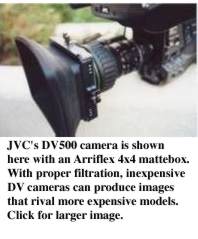 So you're
spending $5,000 on a DV camera. It may be miniDV, DVCAM, or DVCPRO
with impressive specifications - high resolution up to 800 lines,
a 16X zoom, low-light capability less than one lux, and the list
goes on. But at $5,000 or less, there is something you're not
getting - a top-end lens. So you're
spending $5,000 on a DV camera. It may be miniDV, DVCAM, or DVCPRO
with impressive specifications - high resolution up to 800 lines,
a 16X zoom, low-light capability less than one lux, and the list
goes on. But at $5,000 or less, there is something you're not
getting - a top-end lens.
To the novice shooter at first glance,
the lenses found on the XL-1, DV500, and similar models do an
adequate job. They're easy to use, relatively fast, and pretty
versatile. Unfortunately upon closer scrutiny, we find these
optics woefully lacking in critical sharpness and contrast -
serious deficiencies that must be compensated for electronically.
For example, to compensate for poor resolution
camera designers often will resort to such underhanded tricks
as simply cranking up the electronic detail, a tactic that places
a plastic edge around anything the camera senses should be in
focus.
Softening the effect using the popular
Black Pro Mist often doesn't help; some cameras' DSPs think the
lens is merely dirty and crank up the detail even more, resulting
paradoxically in a more electronic-looking image.
In the same vein, some auto-focus models
have the nasty habit of focusing on the filter itself, specifically
on the micro droplets in the Black Pro Mist or image elements
embedded in the Black Diffusion FX or Softnet.
Of course, you could spend $20,000 on
a true broadcast lens, assuming your camera will accept interchangeable
lenses in the first place. But this is hardly a reasonable or
economical solution. Rather, experienced shooters have to understand
the optical limitations of their cameras, and accept the inherent
compromises related to focus, contrast, and speed, especially
at longer focal lengths and when shooting exteriors at tiny apertures.
While no filter can compensate for a
grossly inferior lens, the clever use of filters can improve
image quality substantially. Becoming familiar with the unique
characteristics of your camera can also help. Shooters working
with Panasonic's AJ-D215, for example, should consider de
rigeur a warming filter like the Tiffen 812 to help skin
tones. On the other hand, Sony DSR-PD100A shooters would probably
want to forego the warming filter because of the camera's tendency
to reproduce pleasing flesh tones naturally.
When shooting DV outdoors at midday,
I usually recommend shooting with at least a 0.6 or 0.9 neutral
density filter (in addition to the built-in ND), as well as some
sort of contrast control and/or diffusion to soften the hard
shadows. As many of us have discovered, DV can look horrific
in bright daylight because of its tiny chipset, primitive DSP,
and less-than-ideal optics.
So beware. Shooting DV without at least
some filtration can be perilous to your images and your career
- not to mention those you love.
The DV Emulsion Test
One normally doesn't think of performing
an emulsion test when evaluating video cameras and filters, but
that's exactly what I did. In the film world, it has long been
a common practice for shooters to test the responsiveness of
a new stock prior to beginning a project. The purpose is to evaluate
the degree of detail that can be reproduced in the shadow areas
of your subject. By varying the fill light in conjunction with
the camera's f-stop, the shooter could gain valuable insight
into the limitations of the capturing medium.
Shooting small-format DV today requires
a similar understanding of your camera's responsiveness to shadow
detail. In my evaluations of nearly 100 diffusion filters, I
tried to gauge the relative responsiveness and apply a subjective
judgment. What looked best? Which filter gave me the most pleasing,
textured, professional look on each camera? Before we get to
that, you should understand that we're not talking strict science
here. I am simply offering my opinion of what seems to work well
based on my 20 years of camera experience. It is up to you in
your own assignments and applications to fine-tune my recommendations,
perhaps by adding or subtracting one grade of density in keeping
with your own tastes and innate sense of craft.
My evaluations covered the range of Tiffen's
prodigious filter line: from Pro Mist and Black Pro Mist to Soft
FX, Black Diffusion FX, and Softnet filters in various grades,
including the many warm configurations. My conclusion is that
the ideal diffusion filter for your DV camera may not exist yet.
Nevertheless, here are my recommendations:
Canon XL1
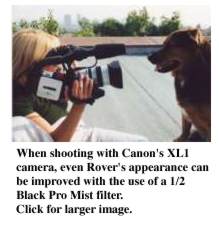 Undoubtedly
one of the most popular DV cameras in the world, my test XL1
model came equipped with a 16X auto-focus lens and an image in
desperate need of a professional makeover. Featuring the harshest
image of any camera I tested, the XL1's visual quality may only
be described as "grating with a strong curse." Undoubtedly
one of the most popular DV cameras in the world, my test XL1
model came equipped with a 16X auto-focus lens and an image in
desperate need of a professional makeover. Featuring the harshest
image of any camera I tested, the XL1's visual quality may only
be described as "grating with a strong curse."
Videomaker Susan di Rende of Los Angeles
says the look is reminiscent of a "poorly played brass instrument.
Hyper-reality at its worst," she adds, even as she continues
to use the camera precisely for its hyper-real look.
Di Rende's preferences notwithstanding,
I was able to dramatically improve the XL1's performance. While
the old standby 1/2 Black Pro Mist proved to be of little help,
producing a murky and confused image (even at a 1/4 and 1/8 grades),
the camera responded well to Tiffen's new 1/2 Black Diffusion
FX filter. The resultant image is tasteful and sharp; the diffused
look not at all obvious or brassy. What a difference!
The Soft FX offers another excellent
solution for XL1 owners, although this filter, even in the minimum
1/2 grade, may be a bit heavy for nonfiction applications. The
principal difference between the Black Diffusion FX and Soft
FX is the degree of apparent diffusion. The Soft FX produces
a noticeably diffused look while the Black Diffusion FX maintains
absolute sharpness along with the diffusion. Incredible!
One world of caution however if you're
considering the Black Diffusion FX for your XL-1 (or other small-format
DV camera). Like any similar filter (or net) with large image
elements or engravings, the BDFX should NOT be used with your
lens at full-wide position and stopped down beyond F4. In other
words when shooting exteriors, you MUST maintain an F4 or larger
iris setting to prevent the filter element pattern from appearing
on the screen.
Sony DSR-PD100A
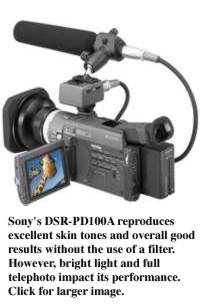 Unlike the XL1,
the Sony model is kinder from the outset, reproducing excellent
skin tones and generally pleasing results - even without filtration.
On the other hand, shooting stopped-down in bright light (never
recommended) or at full telephoto (sometimes necessary) seriously
impacts the Sony's performance. Unlike the XL1,
the Sony model is kinder from the outset, reproducing excellent
skin tones and generally pleasing results - even without filtration.
On the other hand, shooting stopped-down in bright light (never
recommended) or at full telephoto (sometimes necessary) seriously
impacts the Sony's performance.
Interestingly, I found the 1/2 Black
Diffusion FX less helpful on the PD100A than on the other cameras
in this class. This may be because of the camera's tiny 1/4-inch
chipset or the relatively small front diameter of the primary
lens (not the wide-angle adapter), which decreases the effect
of certain filters, such as the Black Diffusion FX, that contain
prominent image elements.
Whatever the case, the 1/2 grade is too
strong in my opinion for most users of the PD100A. The recent
introduction of the 1/4 grade Black Diffusion FX is a godsend
to small-format DV shooters in general, and PD100A owners in
particular. For general exterior use, I recommend my old standby
- the 1/8 Black Pro Mist - to reduce noise and add a very slight
diffusion effect. The gains aren't enormous but they are noticeable
and definitely worth the effort.
From a practical point of view, the use
of the Black Pro Mist outdoors eliminates the risk of seeing
the engraved pattern in the BDFX or Softnet on screen - a distinct
advantage for 'run-and-gun'-type projects.
Panasonic AJ-D215
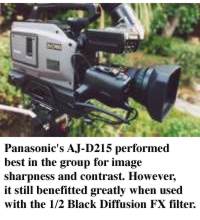 Head
and shoulders above the other models in this group in terms of
image sharpness and contrast, the Panasonic AJ-D215 produces
a true professional image from the get-go. Equipped with a 1/3-inch
chipset and a detachable10X Fujinon zoom lens, the camera produces
cool and crisp images that are not nearly as grating as the Canon
XL-1 or JVC DV500. Head
and shoulders above the other models in this group in terms of
image sharpness and contrast, the Panasonic AJ-D215 produces
a true professional image from the get-go. Equipped with a 1/3-inch
chipset and a detachable10X Fujinon zoom lens, the camera produces
cool and crisp images that are not nearly as grating as the Canon
XL-1 or JVC DV500.
Nevertheless, like the Canon, I found
the Panasonic benefitted substantially from the 1/2 Black Diffusion
FX, producing exceptional results, especially when combined with
Tiffen's 812 warming filter. Please note that Tiffen has recently
introduced a "warm" version of the BDFX , thus obviating
the need to stack the additional 812.
The Panasonic D215 appeared to respond
very well to another Tiffen favorite, the Softnet 1B. The industrial-grade
Fujinon T17X5BRM4 f/1.4 fitted to the Panasonic camera may have
a lot to do with it, but if you're shooting dramatic programs
with the D215, the Softnet 1B or 1S used to enhance skin tones
are excellent diffusion options.
And just to be completely clear on this
point, you MUST exercise care with any filter with pronounced
image elements to prevent the pattern from appearing onscreen.
When shooting with the BDFX or front-mounted net especially,
always operate as close to wide-open as possible and take care
to avoid light directly striking the filter.
JVC GY-DV500
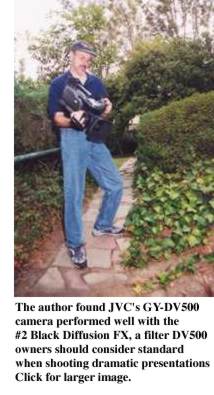 Based
on technical specifications alone, this is a lot of camera for
the money. With a 3CCD, 1/2-inch chipset, 800 lines of resolution,
and a 14-bit digital signal processor, you'd expect the JVC to
respond well to most professional filtration schemes. And luckily
it does. Based
on technical specifications alone, this is a lot of camera for
the money. With a 3CCD, 1/2-inch chipset, 800 lines of resolution,
and a 14-bit digital signal processor, you'd expect the JVC to
respond well to most professional filtration schemes. And luckily
it does.
Unique in its class, the DV500 offers
trues manual tweaking under the hood for those with a substantial
engineering background. Without this tweaking however, I found
the unfiltered image out of the DV500 to be almost as harsh as
the Canon XL-1. This is despite the better-than-average Canon
18X lens (model YH18X6.7K12U) fitted to my evaluation camera
by JVC. Compared to the mediocre lens initially provided with
the unit, the Canon produces far better images with substantially
less breathing and ramping at extended focal lengths.
In my evaluations, the JVC performed
very nicely with a #2 Black Diffusion FX - a filter that DV500
camera owners ought to consider as the standard for dramatic
presentations. The #1 Warm Soft FX performed almost as well with
a nice diffused look without the obvious "I'm-using-a-filter-now"
curse. The Warm Soft FX provides the additional benefit of enhanced
skin tones - a substantial improvement over the camera's generally
cool presentation.
Notably, the Warm Soft FX, designed without
the pronounced image elements of the Black Diffusion FX, may
be used for exteriors without fear of seeing the engraving pattern
at smaller apertures.
Unlike the Canon XL-1 and Sony DSR-PD100A,
the DV500 - perhaps owing to its larger chipset - responded satisfactorily
to the 1/2 Black Pro Mist, yielding a slightly diffused look
suitable for corporate and general use. The warm version of the
Pro Mist has traditionally been an excellent choice for corporate
interviews and continues to be on the DV500.
For a more sophisticated look on nonfiction
programs, shooters can opt for the Black Diffusion FX in a weaker
1/2 grade, which looked every bit as pleasing on the JVC as it
did on the other cameras in this evaluation. For industrial applications,
however, sometimes less is more. So both options may be worth
trying.
 The DV500 benefits
considerably from a warming filter - either as a standalone 812
or combined with the Warm Pro Mist, Warm Soft FX, or in the new
(just released) warm version of the Black Diffusion FX. The DV500 benefits
considerably from a warming filter - either as a standalone 812
or combined with the Warm Pro Mist, Warm Soft FX, or in the new
(just released) warm version of the Black Diffusion FX.
By any measure, the Black Diffusion FX
is as close as one can imagine to the ideal small-format DV filter.
Amazing as it seems, the Black Diffusion FX not only reduces
the format's inherent harshness by imparting a subtle and tastefully
diffused look, it does so while still maintaining absolute image
sharpness. This is a huge advantage to DV shooters nobly struggling
with less-than-ideal optics, DSPs, and all of the other consequences
of not having spent $50,000 on a camera package.
Two years ago when Tiffen introduced
the Black Diffusion FX, it was hailed as a new kind of filter
that cleverly retained the diffusion properties of the Soft FX
without the accompanying loss of sharpness. Now with small-format
DV cameras increasingly being used in fully professional productions,
the huge advantage of such a filter is obvious, especially when
shooting interiors and when aperture control is possible under
bright conditions outdoors
.
Of course there still are many applications
for which the Black Pro Mist and Warm Pro Mist serve adequately.
The 1/8 grade, for example, works very well in videos intended
for the Web. The slight diffusion offered helps reduce digital
noise and harshness without creating resolution problems that
may come back to haunt you later. The warm version further serves
to enhance skin tones - another plus.
Obviously, there are many filter strategies
possible for a given application or project. As shooters, we
are expected to consistently provide high-quality images, regardless
of the format or level of equipment we happen to be working with.
Creating images consistent with a show's
mood and texture is the goal of every cameraperson. With the
advent of ingenious filters, such as Tiffen's Black Diffusion
FX, shooters with even the lowest-rung DV camera can produce
images that rival the finest broadcast gear. So, shooters, you
no longer need to fear the DV hex. With help from the correct
filter, the curse of digital video can be overcome at last.
Barry Braverman is a veteran director of photography
based in Los Angeles with more than 18 years of experience as
a nonfiction specialist. He can be reached at bbrave@mindspring.com.
This article
was originally published on www.videosystems.com and is reprinted here
with permission
|